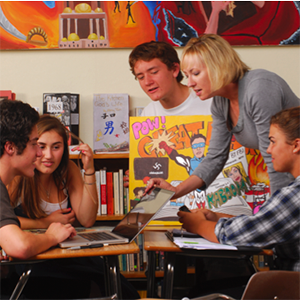
As I write, it’s December 26, Boxing Day: a time for resetting, relaxing, and left-overing. But I’m looking forward to getting back to my school and my co-workers. And by “co-workers,” I don’t mean the Spanish teacher down the hall or the Chem teacher over in the lab. I mean the people with whom I log the most hours constructing knowledge: my students. This is not to say that our young charges are teaching colleagues. They lack training, experience, and a fully formed pre-frontal cortex. So why might we think of them as co-workers?
Because in setting up effective relational structures, embracing what they have to teach us, and humbly letting go of a need to provide all the answers, we grow as educators and provide a model for inter-generational collaboration.
Relational Structures
The model of Project-Based Learning is a first step toward thinking of students as co-workers. The relational structures inherent in this pedagogy frame the teacher as facilitator, coach, cheerleader for their educational victories. Rather than the “sage on the stage,” we become the “guide on the side.” Rather than gatekeepers decrying “Gotcha!” we pose questions that lead toward discovery. When we align ourselves on the side of our students en route toward a project, we maintain an adult/adolescent boundary while rendering power struggles inert.
Open-Mindedness
 Receptivity to our students’ ideas builds the trust necessary for co-work. Twenty years ago I was a French major aiming to fulfill a science requirement in a Genetics class. For our final evaluation, the professor offered a choice between exam or essay. Three humanities-minded friends and I, all out of our comfort zones, proposed instead that we create a short film about a genetic issue in society. (This was in the days before iPhone, iMovie, and the mapping of the human genome.) Our professor welcomed the idea, and Gene of Darkness was born. This teacher’s open-mindedness is one of my most memorable educational experiences because he trusted us with our learning. Honor that model by paying it forward to your own classes, giving your students not only choice but agency in how they demonstrate their learning.
Receptivity to our students’ ideas builds the trust necessary for co-work. Twenty years ago I was a French major aiming to fulfill a science requirement in a Genetics class. For our final evaluation, the professor offered a choice between exam or essay. Three humanities-minded friends and I, all out of our comfort zones, proposed instead that we create a short film about a genetic issue in society. (This was in the days before iPhone, iMovie, and the mapping of the human genome.) Our professor welcomed the idea, and Gene of Darkness was born. This teacher’s open-mindedness is one of my most memorable educational experiences because he trusted us with our learning. Honor that model by paying it forward to your own classes, giving your students not only choice but agency in how they demonstrate their learning.
Humility
Thinking of students as co-workers takes humility. We want students to have confidence in us, and we think that means we have to present a perfectly intact façade. Ironically, trust comes more quickly when students see that we are learners just like they are. Trying to pass for more confident or knowledgeable than we are will only put cracks in the relational foundation we’re trying to build. But admitting what we don’t know is an act of courageous vulnerability. So take a leap of faith: launch a new project and ask students for feedback on your process. The wise teacher takes educational risks, admits uncertainty, and models that both of these are necessary steps on the path to learning.
Re-framing our associations with students grounds our work in relationship and leads to the mutually respectful connection that is the basis of effective collaboration. By creating trusting relational structures, openly receiving student ideas, and cultivating a profound humility along the learning process, we avoid the trap of locking horns with students. We treat our youth as the co-workers they are and model what it means to collaborate. If we believe deeply that each member of a classroom is a both a teacher and a learner, and that learning can — and must — go both ways, then in that respect we truly are co-workers.
